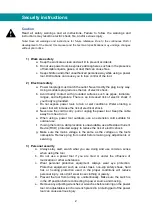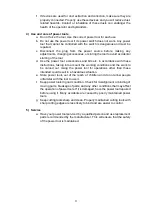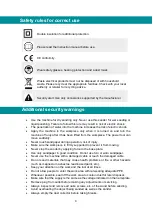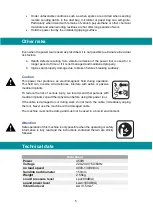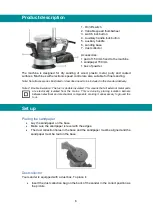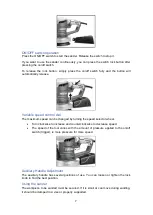
8
Be sure to hold the sander firmly while it is on and apply it gently to the work, as it can
"bump" on first contact. Hold the sander so it is flat on the work and move it slowly,
preferably in a smooth, circular motion. Regularly check the condition of the sandpaper
and replace it when worn for best results.
Work tips
1. Your sander is useful for working on wood, metal, and painted surfaces. Will
smooth surfaces before painting, even when fillers have been used and allowed
to bleed.
2. Your sander is best suited for large, flat areas such as doors, but can also be
used on baseboards, windows, etc., as long as they are accessible.
3. Different types of sandpaper will allow the sander to meet various needs.
Different grades of sandpaper are available, the higher the grade number, the
finer the grit. For rough work, start with a low grit grade (ie 60 grade) and move
to a higher, finer grade (ie 100 or 120) for finishing. If you use a fine grade for
rough surfaces, it will soon clog and need to be replaced.
4. At all times, let the sander do the work; do not force or apply excessive pressure
to the sandpaper or it may wrinkle or tear. Preferably use a light circular motion.
5. If the surface shows excessive formation due to abrasive motion, you may be
using too coarse a grit or applying too much pressure.
Maintenance and cleaning
Maintenance
•
Your power tool requires no additional lubrication or maintenance. There are no
user-serviceable parts in your power tool.
•
Always store your power tool in a dry place.
•
Keep the motor ventilation slots clean.
•
If you see sparks in the ventilation slots, this is normal and will not harm your
power tool.
•
If the power cord is damaged, it must be replaced with a special cord or assembly
available from the manufacturer or its service agent.
Cleaning
•
Keep tool air vents unclogged and clean at all times.
•
Never use water or chemical cleaners to clean your power tool. Clean with a dry
towel.
•
Remove dust and dirt regularly. Cleaning is best done with a soft brush or cloth.
Summary of Contents for TF2041506
Page 1: ...1 v ROTO ORBITAL SANDER...
Page 10: ...10 Exploded view...
Page 11: ...11 ROTO ORBITAL SANDER...


